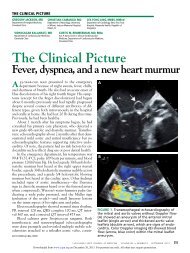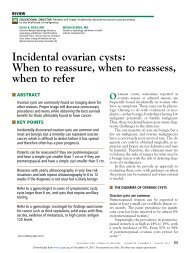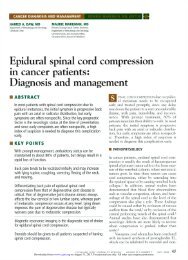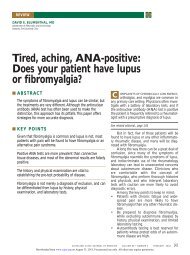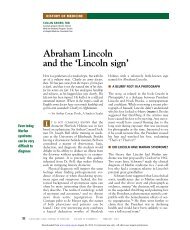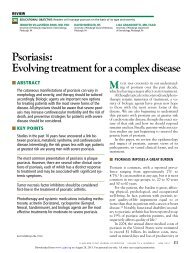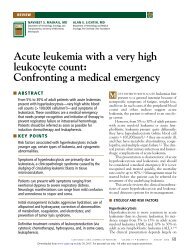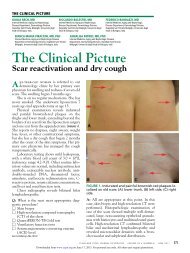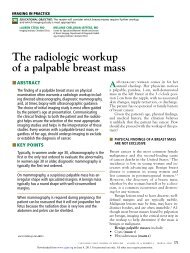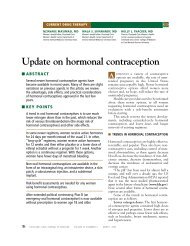Mechanical treatment of heart failure: The growing role of LVADs ...
Mechanical treatment of heart failure: The growing role of LVADs ...
Mechanical treatment of heart failure: The growing role of LVADs ...
Create successful ePaper yourself
Turn your PDF publications into a flip-book with our unique Google optimized e-Paper software.
REVIEW<br />
HASSAN W. NEMEH, MD<br />
Department <strong>of</strong> Thoracic and Cardiovascular<br />
Surgery, Loyola University Medical Center,<br />
Maywood, Ill<br />
NICHOLAS G. SMEDIRA, MD<br />
Department <strong>of</strong> Thoracic and Cardiovascular<br />
Surgery, <strong>The</strong> Cleveland Clinic<br />
<strong>Mechanical</strong> <strong>treatment</strong> <strong>of</strong> <strong>heart</strong> <strong>failure</strong>:<br />
<strong>The</strong> <strong>growing</strong> <strong>role</strong> <strong>of</strong> <strong>LVADs</strong><br />
and artificial <strong>heart</strong>s<br />
■ ABSTRACT<br />
Left ventricular assist devices (<strong>LVADs</strong>) and artificial <strong>heart</strong>s<br />
are improving. <strong>The</strong>se devices can prolong a patient’s life<br />
while on a <strong>heart</strong> transplant list. More exciting, mechanical<br />
assistance may provide an opportunity for a damaged <strong>heart</strong><br />
to recover some function. Still, despite the promise, the use<br />
<strong>of</strong> these devices raises some difficult cost-benefit and<br />
ethical questions.<br />
■ KEY POINTS<br />
<strong>LVADs</strong> have proved very effective in sustaining very ill<br />
patients to transplantation, reversing shock, restoring endorgan<br />
function, and improving functional status.<br />
A randomized trial showed that the survival rate was higher<br />
among patients with end-stage <strong>heart</strong> <strong>failure</strong> who received<br />
an LVAD as permanent therapy vs intensive medical<br />
therapy, but rates <strong>of</strong> device <strong>failure</strong>, pump valve malfunction,<br />
and device-related infections were high and worsened<br />
quality <strong>of</strong> life and survival.<br />
When to insert the LVAD poses a dilemma. Putting it in too<br />
early could subject the patient to an avoidable procedure<br />
with its risk and cost. A delay putting it in could lead to<br />
end-organ damage with an increased risk <strong>of</strong> operative<br />
morbidity and mortality.<br />
<strong>The</strong> next generation <strong>of</strong> devices will include totally<br />
implantable systems and smaller rotary pumps. <strong>The</strong>se<br />
should have fewer complications, leading to improvement<br />
in the patient’s quality <strong>of</strong> life at a lower overall cost.<br />
This paper discusses therapies that are experimental or that are not approved by the US Food and<br />
Drug Administration for the use under discussion.<br />
S THERE a mechanical fix for end-stage<br />
<strong>heart</strong> <strong>failure</strong>?<br />
Artificial <strong>heart</strong>s and left ventricular assist<br />
devices (<strong>LVADs</strong>) were once medical novelties,<br />
but they have been improving over the past 30<br />
years, and their use is expanding. <strong>The</strong> US Food<br />
and Drug Administration has approved some<br />
<strong>of</strong> them to keep <strong>heart</strong> transplant candidates<br />
alive until a donor <strong>heart</strong> becomes available (a<br />
“bridge to transplantation”).<br />
See related editorial, page 177<br />
Perhaps most exciting, there are indications<br />
that in some cases, mechanical<br />
support may reverse the remodeling<br />
process <strong>of</strong> <strong>heart</strong> <strong>failure</strong> at all levels, leading<br />
to functional recovery (a “bridge to recovery”).<br />
Unfortunately, to date only a minority<br />
<strong>of</strong> patients can be weaned from the support<br />
devices and do well over the long<br />
term.<br />
A recent trial found that, in some patients<br />
<strong>LVADs</strong> may have a <strong>role</strong> as permanent or “destination”<br />
therapy. <strong>The</strong> study found that in<br />
patients with severe <strong>heart</strong> <strong>failure</strong> who were not<br />
transplantation candidates, survival was<br />
greater with an LVAD than with intensive<br />
medical support.<br />
But the complication rate <strong>of</strong> this expensive<br />
technology remains high, and difficult<br />
ethical questions surround who should get this<br />
therapy and who should not.<br />
This paper reviews the various types <strong>of</strong><br />
mechanical circulatory support systems,<br />
how they have evolved, and trends for the<br />
future.<br />
CLEVELAND CLINIC JOURNAL OF MEDICINE VOLUME 70 • NUMBER 3 MARCH 2003 223<br />
Downloaded from<br />
www.ccjm.org on June 7, 2013. For personal use only. All other uses require permission.<br />
I
Problems with<br />
<strong>LVADs</strong>:<br />
• Stroke<br />
• Infection<br />
• Device <strong>failure</strong><br />
ARTIFICIAL HEARTS NEMEH AND SMEDIRA<br />
T ABLE 1<br />
National mechanical circulatory support programs<br />
YEAR INSTITUTE, BRANCH, AND GOALS<br />
1964 National Heart Institute<br />
Artificial Heart Program<br />
Goals: Component parts for circulatory support systems<br />
1970 National Heart and Lung Institute<br />
Medical Applications Branch<br />
Goals: Temporary assist systems<br />
Permanent assist systems<br />
Totally implantable artificial <strong>heart</strong><br />
1977 National Heart, Lung, and Blood Institute<br />
Devices and Technology Branch<br />
Goals: Left <strong>heart</strong> assist pumps<br />
Electrical converters to power and control the pumps<br />
1980 National Heart, Lung, and Blood Institute<br />
Devices and Technology Branch<br />
Goals: Implantable, integrated, electric left <strong>heart</strong> assist systems, designed to provide<br />
support for more than 2 years<br />
1994 National Heart, Lung, and Blood Institute<br />
Devices and Technology Branch<br />
Goals: Innovative ventricular assist systems<br />
■ AN EPIDEMIC OF HEART FAILURE<br />
<strong>The</strong>se devices are needed because <strong>heart</strong> <strong>failure</strong><br />
is epidemic and other therapies are limited.<br />
Chronic <strong>heart</strong> <strong>failure</strong> syndrome is the<br />
leading cause <strong>of</strong> death in the United States<br />
and much <strong>of</strong> the developed world. 1 From 1979<br />
to 1998, deaths due to this disorder increased<br />
by 135%. <strong>The</strong> incidence <strong>of</strong> chronic <strong>heart</strong> <strong>failure</strong><br />
approaches 10 per 1,000 people over the<br />
age <strong>of</strong> 65 years, and the 5-year mortality rate is<br />
close to 50%, despite advances in its medical<br />
and surgical <strong>treatment</strong>. 2<br />
Transplantation, the <strong>treatment</strong> <strong>of</strong> choice<br />
for <strong>heart</strong> <strong>failure</strong> that is intractable despite optimal<br />
medical therapy, is limited by a shortage <strong>of</strong><br />
donor organs and by patient ineligibility due to<br />
age and comorbidities. 3 Of the 4,200 patients<br />
on the <strong>heart</strong> transplant waiting list in the<br />
United States, only 2,185 per year will receive<br />
a transplant, and 15% will die while waiting. 4<br />
Artificial <strong>heart</strong>s and <strong>LVADs</strong> might provide<br />
a bridge to transplantation for some <strong>of</strong><br />
these patients. In addition, thousands <strong>of</strong><br />
DATA FROM FRAZIER OH. MECHANICAL CARDIAC ASSISTANCE: HISTORICAL PERSPECTIVES.<br />
SEMIN THORAC CARDIOVASC SURG 2000; 12:207–219.<br />
patients each year who are not eligible for<br />
transplants may benefit from one <strong>of</strong> these<br />
devices. 5<br />
■ HISTORY OF ARTIFICIAL HEARTS<br />
An LVAD was first used clinically in 1963, 6<br />
and an implanted total artificial <strong>heart</strong> was<br />
used as a bridge to transplantation in 1969. 7<br />
Widespread use <strong>of</strong> these devices had to<br />
wait, however, until the late 1980s and early<br />
1990s, when government-sponsored research<br />
(TABLE 1) resulted in reliable and safe pumps.<br />
Since then, more than 5,800 patients have<br />
received these devices, mostly intended as<br />
bridges to transplantation. 8 More recently,<br />
<strong>LVADs</strong> and total artificial <strong>heart</strong>s have been<br />
used as permanent supportive therapy.<br />
■ PUMP DESIGN<br />
<strong>LVADs</strong> receive blood from the left ventricle<br />
via an inflow cannula and pump it into the<br />
aorta via an outflow cannula. If both ventri-<br />
224 CLEVELAND CLINIC JOURNAL OF MEDICINE VOLUME 70 • NUMBER 3 MARCH 2003<br />
Downloaded from<br />
www.ccjm.org on June 7, 2013. For personal use only. All other uses require permission.
T ABLE 2<br />
Comparison <strong>of</strong> available cardiac devices<br />
SELECTED PULSATILE PUMPS<br />
Thoratec<br />
Indications: Right, left, or biventricular support<br />
Advantages: Fits in a wide range <strong>of</strong> patient sizes (body surface area 0.73 to 2.5 m 2)<br />
Pump can be changed without invasive surgery<br />
Can replace the entire function <strong>of</strong> the supported ventricle<br />
Disadvantages: Need for strict anticoagulation with risk <strong>of</strong> bleeding or thromboembolism<br />
Large lines crossing the skin with a high risk <strong>of</strong> infection<br />
Limited patient mobility<br />
Not approved for home use<br />
HeartMate<br />
Indications: Left ventricular support<br />
Advantages: No need for anticoagulation<br />
Portability <strong>of</strong> controller and batteries permits good patient mobility and hospital discharge<br />
Can replace the entire function <strong>of</strong> the supported ventricle<br />
Disadvantages: Drive line crossing the skin poses a risk <strong>of</strong> infection<br />
Left ventricle support only<br />
Does not fit in patients with body surface area ≤ 1.5 m 2<br />
Novacor<br />
Indications: Left ventricular support<br />
Advantages: Portability <strong>of</strong> controller and batteries permits good patient mobility and hospital discharge<br />
Can replace the entire function <strong>of</strong> the supported ventricle<br />
Disadvantages: Need for strict anticoagulation with higher risk <strong>of</strong> bleeding or thromboembolism<br />
Drive line crossing the skin poses a high risk <strong>of</strong> infection<br />
Left ventricle support only<br />
Does not fit in patients with body surface area ≤ 1.5 m2 CONTINUOUS-FLOW PUMPS<br />
Indications: Left ventricular support<br />
Advantages: Small size permits greater patient mobility<br />
Quiet<br />
Fit in a wide range <strong>of</strong> patient body habitus<br />
Disadvantages: Need anticoagulation; risk <strong>of</strong> bleeding and thromboembolism unknown<br />
May not replace the entire function <strong>of</strong> the supported ventricle<br />
Nonpulsatile flow<br />
Still in early clinical trials<br />
TOTAL ARTIFICIAL HEARTS<br />
Indications: Advanced biventricular dysfunction<br />
Pulmonary hypertension?<br />
Cardiac tumors?<br />
Advantages: Complete replacement <strong>of</strong> the <strong>heart</strong> function<br />
Disadvantages: Need anticoagulation; risk <strong>of</strong> bleeding or thromboembolism<br />
Due to the size <strong>of</strong> equipment, they only fit in patients with larger body habitus<br />
Still in early clinical trials<br />
CLEVELAND CLINIC JOURNAL OF MEDICINE VOLUME 70 • NUMBER 3 MARCH 2003 225<br />
Downloaded from<br />
www.ccjm.org on June 7, 2013. For personal use only. All other uses require permission.
ARTIFICIAL HEARTS NEMEH AND SMEDIRA<br />
A paracorporeal biventricular<br />
support system<br />
Outflow<br />
conduit<br />
Inflow<br />
conduit<br />
Right-sided<br />
pump<br />
Pneumatic<br />
drive line<br />
FIGURE 1. <strong>The</strong> Thoratec biventricular support system.<br />
Outflow<br />
conduit<br />
Inflow<br />
conduit<br />
Left-sided<br />
pump<br />
CCF<br />
©2003<br />
cles are failing, two pumps or a total artificial<br />
<strong>heart</strong> can be used. Energy and control sources<br />
activate and monitor the pump.<br />
Like the body’s own <strong>heart</strong>, most devices<br />
pump blood in pulses, which poses an engineering<br />
challenge. Pulsatile pumps need both<br />
an energy source, either pneumatic or electrical,<br />
to drive the pump and a mechanism for air<br />
to move in and out as the blood chamber fills<br />
and empties. 9<br />
To solve these problems, all <strong>of</strong> the firstgeneration<br />
pumps used an external drive<br />
mechanism connected by a drive line that<br />
passes either compressed air or electricity<br />
through the skin. <strong>The</strong>re is also a need for an<br />
external vent. Unfortunately, the need for a<br />
drive line crossing through the skin creates a<br />
high risk <strong>of</strong> infection, a key complication <strong>of</strong><br />
these early devices. In addition, the patient’s<br />
quality <strong>of</strong> life is reduced by the need to be<br />
tethered to an external power source.<br />
For later devices, it has been relatively easy<br />
to solve the problem <strong>of</strong> an external drive line.<br />
A controller and powerpack can be placed subcutaneously,<br />
and charged through the skin via<br />
an induction coil. However, creation <strong>of</strong> an<br />
internal venting system is more difficult. <strong>The</strong>re<br />
are three solutions to the problem:<br />
• An internal compliance chamber, a kind<br />
<strong>of</strong> small internal balloon, into which air from<br />
the pump can move in and out (used in the<br />
LionHeart Left Ventricular Assist System).<br />
• An internal hydraulic pump that oscillates<br />
between two chambers (used in the AbioCor<br />
Implantable Replacement Heart). In this system<br />
a piston moves between two chambers. As<br />
it moves in one direction, chamber A fills with<br />
blood, while chamber B is emptied. As the piston<br />
reverses direction, chamber A is emptied<br />
<strong>of</strong> blood, and chamber B is filled.<br />
• A nonpulsatile system (eg, the Jarvik<br />
2000). In this system, similar to a car’s water<br />
pump, blood is moved continuously and pulselessly,<br />
requiring no venting.<br />
Some <strong>of</strong> the pulsatile pumps can be synchronized<br />
to the patient’s <strong>heart</strong>beat, but most<br />
run by sensing when the pump chamber is full.<br />
If the right side <strong>of</strong> the <strong>heart</strong> pumps more blood<br />
and fills the pump faster, the pump will beat<br />
faster. <strong>The</strong> nonpulsatile or rotary pumps to<br />
date run at a fixed rate.<br />
■ PUMPS IN CLINICAL USE<br />
Before we can discuss the indications for<br />
mechanical support, an overview <strong>of</strong> the types<br />
<strong>of</strong> devices is needed (TABLE 2).<br />
Partially implantable pulsatile pumps<br />
<strong>The</strong> Thoratec Ventricular Assist Device is<br />
paracorporeal: the pump is literally outside the<br />
body, with inflow and outflow cannulae that traverse<br />
the skin. <strong>The</strong> valves are mechanical.<br />
Quality <strong>of</strong> life for the patient is not optimal,<br />
but this system actually has some advantages.<br />
Because the pump is outside the body, it<br />
can be used in small patients, and two pumps<br />
can be ganged together for biventricular support<br />
(FIGURE 1). 10 Recently a new, smaller console<br />
was released for use. Approximately the<br />
size <strong>of</strong> a small suitcase, it allows for greater<br />
226 CLEVELAND CLINIC JOURNAL OF MEDICINE VOLUME 70 • NUMBER 3 MARCH 2003<br />
Downloaded from<br />
www.ccjm.org on June 7, 2013. For personal use only. All other uses require permission.
patient mobility and independence than the<br />
old console, which was the size <strong>of</strong> a washing<br />
machine.<br />
<strong>The</strong> Novacor Left Ventricular Assist<br />
System and the HeartMate Left Ventricular<br />
Assist System are both intracorporeal<br />
<strong>LVADs</strong>. <strong>The</strong>y have porcine valves. Both have<br />
portable controllers that permit the patient to<br />
be discharged from the hospital and to be<br />
more mobile. 11,12 <strong>The</strong> original HeartMate<br />
1000-IP was pneumatically driven, with drive<br />
lines that traversed the skin. <strong>The</strong> newer<br />
HeartMate V-E and the Novacor are battery<br />
powered with a small portable controller but<br />
still have a tube that traverses the skin. 12<br />
<strong>The</strong> Novacor and HeartMate devices are<br />
approved for use as a bridge to transplantation,<br />
and recently, the HeartMate was recommended<br />
for approval as destination (permanent)<br />
therapy as well. However, these pumps<br />
are large and are therefore indicated only for<br />
patients with a body surface area <strong>of</strong> at least 1.5<br />
m 2. 3,13 <strong>The</strong>y have enough output to completely<br />
take over the function <strong>of</strong> the left ventricle.<br />
3<br />
Except for the HeartMate, all pulsatile<br />
pumps in current use require anticoagulation to<br />
prevent thromboembolism. 12 Modifications in<br />
the Novacor design have reduced the incidence<br />
<strong>of</strong> thromboembolic events from a rate <strong>of</strong><br />
25% to 12% <strong>of</strong> devices implanted.<br />
Totally implantable pumps<br />
<strong>The</strong> LionHeart Left Ventricular<br />
Assist System (FIGURE 2) is an LVAD with<br />
an implantable compliance chamber that<br />
provides internal venting and a transcutaneous<br />
energy transfer system: that is, a<br />
powerpack placed just below the skin that<br />
can be recharged by placing an induction<br />
coil just over it. 14<br />
<strong>The</strong> AbioCor Implantable Replacement<br />
Heart is a total artificial <strong>heart</strong> with a<br />
hydraulic pump that oscillates between the<br />
right and left chambers; one chamber fills<br />
while the other empties. 15 Thus, the ejection<br />
<strong>of</strong> the right and left chambers is sequential<br />
instead <strong>of</strong> synchronous.<br />
Both devices are still under investigation<br />
for clinical utility. Placement <strong>of</strong> the AbioCor<br />
requires excision <strong>of</strong> most <strong>of</strong> the native <strong>heart</strong>;<br />
for that reason this device will be indicated<br />
A totally implantable LVAD<br />
Outflow<br />
conduit<br />
Internal<br />
transcutaneous<br />
energy<br />
transfer<br />
coil<br />
Controller<br />
and internal<br />
power pack<br />
only for patients with severe biventricular<br />
<strong>failure</strong>; elevated, fixed pulmonary vascular<br />
resistance; resectable malignant cardiac<br />
tumors; severe <strong>heart</strong> graft dysfunction; or<br />
massive cardiac necrosis after a myocardial<br />
infarction. 3<br />
Both devices completely do away with<br />
lines traversing the skin, and there have been<br />
no reports <strong>of</strong> pump or pump pocket infections<br />
for either device.<br />
Continuous-flow pumps<br />
Continuous-flow pumps use an impeller, akin to<br />
a turbine blade, to pump blood in a continuous<br />
stream rather than in pulses. Examples are the<br />
DeBakey/NASA and Jarvik 2000 devices 16;<br />
others (eg, CorAid and HeartMate III) are<br />
undergoing development and testing (FIGURE 3).<br />
<strong>The</strong>se pumps are simple and small and<br />
Air infusion<br />
port<br />
Compliance<br />
chamber<br />
Inflow<br />
conduit<br />
Pump<br />
CCF<br />
©2003<br />
FIGURE 2. A totally implantable left ventricular assist device<br />
(LVAD), the LionHeart Left Ventricular Assist System.<br />
CLEVELAND CLINIC JOURNAL OF MEDICINE VOLUME 70 • NUMBER 3 MARCH 2003 229<br />
Downloaded from<br />
www.ccjm.org on June 7, 2013. For personal use only. All other uses require permission.
A continuous-flow pump<br />
Outflow<br />
conduit<br />
Electric<br />
drive line<br />
Power pack<br />
ARTIFICIAL HEARTS NEMEH AND SMEDIRA<br />
FIGURE 3. <strong>The</strong> CorAid ventricular assist device.<br />
Inflow<br />
conduit<br />
Pump<br />
Controller<br />
CCF<br />
©2003<br />
have the potential for wider use. 9 However,<br />
they do not have enough output to replace the<br />
entire function <strong>of</strong> the left ventricle. Rather,<br />
they are intended for patients with end-stage<br />
<strong>heart</strong> <strong>failure</strong> who retain some ventricular<br />
function (New York Heart Association class<br />
III or IV), in whom they provide a “boost” to<br />
support the circulation, thus unloading the<br />
failing <strong>heart</strong> enough to get it back into accordance<br />
with the Frank-Starling mechanism. 3<br />
That is, by reducing the load on overstretched<br />
myocytes, mechanical stress is reduced, giving<br />
them a chance to heal and improving contractility.<br />
Multiple animal studies on continuous flow<br />
suggested that, after an initial period <strong>of</strong> adaptation,<br />
the neurohormonal changes <strong>of</strong> <strong>heart</strong> <strong>failure</strong><br />
such as elevated epinephrine and B-type<br />
natriuretic peptide levels return to baseline. 9,16<br />
It is not known if a pulse is necessary for<br />
long-term organ function, but when these<br />
devices are used for partial support the patient<br />
still has a pulse. Problems with thrombolysis<br />
have been minimal. Thromboembolism and<br />
pump clotting have been seen, but the magnitude<br />
<strong>of</strong> this problem is not yet known.<br />
Although clinical experience with the<br />
continuous-flow devices is in its early stages,<br />
they seem to hold promise as a bridge to transplantation<br />
or recovery or possibly as destination<br />
therapy. 9 Two <strong>of</strong> them might be used<br />
together for biventricular support.<br />
■ INDICATIONS FOR ASSIST DEVICES<br />
In general, an assist device is indicated in<br />
patients with hemodynamic instability in the<br />
face <strong>of</strong> maximum medical therapy (including<br />
inotropes, an intra-aortic balloon pump, or<br />
both). 3,13<br />
<strong>The</strong> hemodynamic criteria for LVAD<br />
implantation usually include a cardiac index <strong>of</strong><br />
less than 2 L/minute/m 2 and a pulmonary wedge<br />
pressure <strong>of</strong> more than 20 mm Hg. Most patients<br />
present with an acute insult such as a myocardial<br />
infarction, myocarditis, or postcardiotomy<br />
syndrome, or with decompensated chronic cardiomyopathy.<br />
At present, patients must be<br />
transplant candidates to receive an LVAD. 13<br />
What type to use?<br />
<strong>The</strong> type <strong>of</strong> device to use depends primarily on<br />
availability and the surgeon’s experience, but<br />
we have found the following principles to be<br />
quite useful.<br />
About 90% <strong>of</strong> patients can be successfully<br />
supported with a pulsatile LVAD, but 10% to<br />
30% <strong>of</strong> patients supported with an LVAD will<br />
manifest significant right ventricular dysfunction<br />
that might dictate right ventricular support<br />
as well. 17<br />
For patients with a right ventricular<br />
infarct, recurrent ventricular tachyarrhythmias,<br />
or severe right ventricular dysfunction<br />
with low pulmonary artery pressures and a<br />
high central venous pressure, a Thoratec Bi-<br />
Ventricular Assist Device (ie, two Thoratec<br />
pumps, one for each ventricle) (FIGURE 1) is the<br />
best choice. 10 Smaller patients (body surface<br />
area < 1.8 m 2) can be very uncomfortable with<br />
the large implantable pulsatile devices.<br />
Currently, the Thoratec system is the best<br />
choice in these patients. In the future, the<br />
230 CLEVELAND CLINIC JOURNAL OF MEDICINE VOLUME 70 • NUMBER 3 MARCH 2003<br />
Downloaded from<br />
www.ccjm.org on June 7, 2013. For personal use only. All other uses require permission.
much smaller continuous-flow pumps will<br />
work well not only in these patients but also<br />
in children.<br />
<strong>The</strong> <strong>role</strong> <strong>of</strong> continuous-flow pumps and<br />
the total artificial <strong>heart</strong> is unclear at present.<br />
Early experience suggests that continuousflow<br />
pumps will be most useful as true assist<br />
devices in patients with some intrinsic cardiac<br />
reserve. 3 End-stage <strong>heart</strong> <strong>failure</strong> appears to be<br />
best supported with a pulsatile LVAD, which<br />
can completely unload the <strong>heart</strong>.<br />
■ OUTCOME STUDIES AND CASE SERIES<br />
<strong>LVADs</strong> as a bridge to transplantation<br />
<strong>LVADs</strong> have proved very effective in sustaining<br />
very ill patients to transplantation, reversing<br />
shock, restoring end-organ function, and<br />
improving functional status. 18,19<br />
At <strong>The</strong> Cleveland Clinic Foundation, 264<br />
patients received 275 <strong>LVADs</strong> as a bridge to transplantation<br />
between January 1991 and December<br />
2002. <strong>The</strong> devices used were Novacor,<br />
HeartMate 1000-IP, and HeartMate V-E.<br />
Sixty-nine percent <strong>of</strong> the patients survived<br />
to transplantation. Infection risk was<br />
high at 0.56 episodes per patient at 30 days,<br />
1.28 at 3 months, and 1.88 at 6 months.<br />
Cerebral infarction risk was 0.15 at 30 days,<br />
0.25 at 3 months, and 0.30 at 6 months. <strong>The</strong><br />
device failed in 21 cases; all but one were<br />
HeartMates. 20 After transplantation, the 1year<br />
survival rate <strong>of</strong> the patients who had<br />
received <strong>LVADs</strong> was similar to the rate in<br />
patients who received transplants without the<br />
need for <strong>LVADs</strong>. 13<br />
<strong>The</strong> results reveal excellent success in an<br />
extremely ill group <strong>of</strong> patients who might<br />
have died without the technology.<br />
When to put in the LVAD poses a dilemma.<br />
Putting it in too early could subject the patient<br />
to an avoidable procedure with its risk and cost.<br />
On the other hand, a delay putting it in can<br />
lead to end-organ damage with an increased risk<br />
<strong>of</strong> operative morbidity and mortality.<br />
Bridge to recovery<br />
Assist devices were initially developed as a<br />
bridge to recovery in patients with postcardiotomy<br />
<strong>heart</strong> <strong>failure</strong>. 1<br />
In a series <strong>of</strong> 965 such patients, 433 (45%)<br />
were weaned from support and 237 (25%)<br />
improved enough to be discharged from the<br />
hospital. Of the patients who were discharged,<br />
86% were in New York Heart Association<br />
<strong>heart</strong> <strong>failure</strong> class I or II. <strong>The</strong>ir 2-year actuarial<br />
survival rate was 82%. 21<br />
Other reports showed similar results in<br />
patients with myocarditis and cardiogenic<br />
shock or shock due to a reversible injury. 22<br />
However, these patients had acute,<br />
reversible injuries. Chronic <strong>heart</strong> <strong>failure</strong> is different,<br />
and the idea <strong>of</strong> using mechanical circulatory<br />
support to promote recovery <strong>of</strong><br />
myocardial function in chronic <strong>heart</strong> <strong>failure</strong><br />
has generated a great deal <strong>of</strong> excitement.<br />
Chronic <strong>heart</strong> <strong>failure</strong> starts with an<br />
index injury (eg, acute myocardial infarction)<br />
that leads to alteration in the mechanical<br />
properties <strong>of</strong> the muscle, which in turn<br />
leads to a remodeling process at the cellular,<br />
molecular, and neurohormonal levels,<br />
resulting in progressive changes in chamber<br />
size and geometry. 22 Functional deterioration<br />
causes perfusion abnormalities and congestion,<br />
which give rise to the clinical features<br />
<strong>of</strong> the syndrome.<br />
Several studies showed that with LVAD<br />
support there is a reversal <strong>of</strong> the remodeling<br />
process at all levels, leading to functional<br />
recovery. 22–24<br />
In a series <strong>of</strong> 105 patients with dilated cardiomyopathy<br />
who received <strong>LVADs</strong>, 25 24<br />
patients were weaned from the device.<br />
Fourteen patients enjoyed stable cardiac function<br />
after being weaned from the device over<br />
an observation period between 3 months and<br />
4.5 years. Heart <strong>failure</strong> recurred in 7 patients<br />
over a period <strong>of</strong> 4 to 24 months. Compared<br />
with the patients whose condition remained<br />
stable, those whose condition deteriorated<br />
had a longer duration <strong>of</strong> <strong>heart</strong> <strong>failure</strong>, needed<br />
longer periods <strong>of</strong> support to meet the criteria<br />
for LVAD removal, and had bigger chamber<br />
sizes and lower ejection fractions.<br />
Of great interest was that improvement in<br />
function on the LVAD disappeared if the support<br />
was continued for longer than 6 months,<br />
suggesting that prolonged rest may lead to<br />
atrophy and fibrosis <strong>of</strong> the myocardium. 25<br />
<strong>The</strong> results are encouraging, but only a<br />
minority <strong>of</strong> patients could be weaned and did<br />
well over the long run. This approach needs<br />
to be studied further to determine prospec-<br />
Criteria for<br />
LVAD use:<br />
• Cardiac<br />
index 20<br />
• Transplant<br />
candidate<br />
CLEVELAND CLINIC JOURNAL OF MEDICINE VOLUME 70 • NUMBER 3 MARCH 2003 231<br />
Downloaded from<br />
www.ccjm.org on June 7, 2013. For personal use only. All other uses require permission.
Survival (%)<br />
ARTIFICIAL HEARTS NEMEH AND SMEDIRA<br />
Left ventricular assist devices<br />
improve survival as ‘destination’ therapy<br />
100<br />
80<br />
60<br />
40<br />
20<br />
0<br />
0<br />
Medical therapy<br />
6<br />
LVAD<br />
12 18<br />
Months<br />
24 30<br />
FIGURE 4. Kaplan-Meier survival curves for 129 patients<br />
with end-stage <strong>heart</strong> <strong>failure</strong> randomized to receive a<br />
left ventricular assist device (LVAD) or medical therapy<br />
in the REMATCH trial.<br />
FROM ROSE EA, GELIJNS AC, MOSKOWITZ AJ, ET AL. LONG-TERM MECHANICAL LEFT VENTRICULAR<br />
ASSISTANCE FOR END-STAGE HEART FAILURE. N ENGL J MED 2001; 345:1435–1443.<br />
REPRODUCED WITH PERMISSION.<br />
tively which patients are candidates, what<br />
parameters indicate recovery, and if any therapies<br />
enhance recovery.<br />
To date, most successful weanings were<br />
in patients with acute and reversible injury.<br />
Of patients with chronic <strong>heart</strong> <strong>failure</strong> who<br />
were weaned from LVAD support, those with<br />
dilated cardiomyopathy seemed to fare better<br />
than those with ischemic cardiomyopathy.<br />
22<br />
Destination therapy<br />
Fewer than half <strong>of</strong> patients in advanced-stage<br />
chronic <strong>heart</strong> <strong>failure</strong> on maximum medical<br />
support survive 1 year. Could <strong>LVADs</strong> have a<br />
<strong>role</strong> as destination therapy in this population?<br />
<strong>The</strong> REMATCH trial (Randomized<br />
Evaluation <strong>of</strong> <strong>Mechanical</strong> Assistance for the<br />
Treatment <strong>of</strong> Congestive Heart Failure)<br />
recently explored that <strong>role</strong>. 26 One hundred<br />
and twenty-nine patients who were not<br />
transplant candidates were randomized to<br />
receive medical <strong>treatment</strong> or a HeartMate<br />
LVAD.<br />
At 1 year, the mortality rate was 48% lower<br />
in the LVAD group than in the medical group.<br />
<strong>The</strong> Kaplan-Meier estimates <strong>of</strong> survival (FIGURE<br />
4) at 1 year were 52% for the LVAD group and<br />
25% in the medical therapy group; at 2 years<br />
the survival rate was 23% in the LVAD group<br />
and 8% in the medical therapy group.<br />
Terminal <strong>heart</strong> <strong>failure</strong> caused the majority<br />
<strong>of</strong> deaths in the medical <strong>treatment</strong> group,<br />
whereas the most common cause <strong>of</strong> death in<br />
the LVAD group was sepsis (41%) followed by<br />
device <strong>failure</strong> (17%).<br />
<strong>The</strong> probability <strong>of</strong> infection with the<br />
device was 28% at 3 months. Most <strong>of</strong> these<br />
infections were at the drive line site or in the<br />
pocket. No system <strong>failure</strong>s were reported at 12<br />
months, but at 24 months the probability <strong>of</strong><br />
system <strong>failure</strong> was 35%. 26<br />
How can permanent LVAD therapy<br />
be made safer?<br />
<strong>The</strong> complication rate <strong>of</strong> this expensive technology<br />
remains high, but this trial shows that an<br />
LVAD as destination therapy has the potential<br />
for better survival than does optimal medical<br />
therapy. Considering that 58% <strong>of</strong> deaths in the<br />
LVAD group were due to infection or mechanical<br />
<strong>failure</strong>, this survival advantage could be<br />
maximized and extended by improving the<br />
design to make it more durable and to reduce<br />
the propensity for infection. <strong>The</strong> first goal could<br />
be reached by simplifying the design, and the<br />
second possibly by making the devices totally<br />
implantable.<br />
Tough ethical questions<br />
about ‘destination’ therapy<br />
In many cases now, and when destination<br />
therapy becomes a reality, mechanical support<br />
is an “end-<strong>of</strong>-life” decision. Devices prolong<br />
life, but do they provide for an acceptable<br />
quality <strong>of</strong> life? At what age is a patient too old<br />
or too sick to consider mechanical support? If<br />
the patient finds life intolerable with the<br />
device, who will turn it <strong>of</strong>f?<br />
In most cases the well-established bioethical<br />
principles <strong>of</strong> respect for patient autonomy<br />
and surrogate decision-making and rejection<br />
<strong>of</strong> futile care will help guide physicians. In<br />
other cases, the answers will be much more<br />
difficult and will need a careful examination<br />
<strong>of</strong> these guiding principles.<br />
232 CLEVELAND CLINIC JOURNAL OF MEDICINE VOLUME 70 • NUMBER 3 MARCH 2003<br />
Downloaded from<br />
www.ccjm.org on June 7, 2013. For personal use only. All other uses require permission.
■ COSTS<br />
<strong>The</strong> cost <strong>of</strong> therapy with mechanical support<br />
is roughly similar to the cost <strong>of</strong> <strong>heart</strong> transplantation.<br />
<strong>The</strong> devices cost approximately<br />
$65,000, and the mean hospital cost aside<br />
from the device is about $200,000 but varies<br />
widely depending on complications.<br />
■ MECHANICAL SUPPORT<br />
WILL BECOME MORE COMMON<br />
We predict that more and more patients with<br />
end-stage <strong>heart</strong> <strong>failure</strong> will be <strong>of</strong>fered a variety<br />
■ REFERENCES<br />
1. Frazier OH. <strong>Mechanical</strong> cardiac assistance: historical<br />
perspectives. Semin Thorac Cardiovasc Surg 2000;<br />
12:207–219.<br />
2. Jessup M. <strong>Mechanical</strong> cardiac-support devices—dreams<br />
and devilish details. N Engl J Med 2001;<br />
345:1490–1493.<br />
3. Frazier OH. Future directions <strong>of</strong> cardiac assistance.<br />
Semin Thorac Cardiovasc Surg 2000; 12:251–258.<br />
4. “Waiting list activity” and “cadaveric transplant.”<br />
Transplant statistics. 11/01/2001. Scientific Registry <strong>of</strong><br />
Transplant Recipients. http://ustransplant.org/.<br />
5. Westaby S. <strong>The</strong> need for artificial <strong>heart</strong>s. Heart 1996;<br />
76:200–206. Accessed February 17, 2002.<br />
6. Hall CW, Liotta D, Henly WS, et al. Development <strong>of</strong><br />
artificial intrathoracic circulatory pumps. Am J Surg<br />
1964; 108:685–692.<br />
7. Frazier OH. Long- term mechanical circulatory support.<br />
In: Edmunds HL, editor. Cardiac Surgery in the Adult.<br />
New York: McGraw-Hill, 1997:1477.<br />
8. Circulatory support. Patients and family. Thoratec.<br />
http://www.thoratec.com/patients/index.htm.Accessed<br />
April 25, 2002.<br />
9. Nose Y, Yoshikawa M, Murabayashi S, Takano T.<br />
Development <strong>of</strong> rotary blood pump technology: past,<br />
present, and future. Artif Organs 2000; 24:412–420.<br />
10. Pennington DG, Oaks TE, Lohmann DP. Extracorporeal<br />
support: <strong>The</strong> Thoratec device. In: Goldstein DJ, Oz MC,<br />
editors. Cardiac Assist Devices. New York: Futura<br />
Publishing Company, 2000:251.<br />
11. Ramasamy N, Vargo RL, Kormos RL, Portner PM.<br />
Intracorporeal support: <strong>The</strong> Novacor left ventricular<br />
assist system. In: Goldstein DJ, Oz MC, editors. Cardiac<br />
Assist Devices. New York: Futura Publishing Company,<br />
2000:323.<br />
12. Goldstein DJ. Intracorporeal support: <strong>The</strong>rmo<br />
Cardiosystems ventricular assist devices. In: Goldstein<br />
DJ, Oz MC, editors. Cardiac Assist Devices. New York:<br />
Futura Publishing Company, 2000:307.<br />
13. Kasirajan V, McCarthy PM, Hoercher KJ, et al. Clinical<br />
experience with long-term use <strong>of</strong> implantable left ventricular<br />
assist devices: indications, implantation, and<br />
outcomes. Semin Thorac Cardiovasc Surg 2000;<br />
12:229–237.<br />
14. Mehta SM, Pae WE. <strong>The</strong> Pennsylvania State University<br />
totally implantable left ventricular assist device and<br />
total artificial <strong>heart</strong>. In: Goldstein DJ, Oz MC, editors.<br />
<strong>of</strong> devices that will fit their needs.<br />
For patients with some retained function,<br />
a booster <strong>of</strong> support can be given as a<br />
bridge to recovery, a bridge to transplantation,<br />
or even as destination therapy, using<br />
small continuous-flow pumps that are<br />
quiet and fit in small patients as well as<br />
large.<br />
For patients who need LVAD support, the<br />
option <strong>of</strong> a totally implantable LVAD will be<br />
available in the near future.<br />
For patients with biventricular <strong>failure</strong>, a<br />
total artificial <strong>heart</strong> that is completely<br />
implantable will <strong>of</strong>fer an excellent option.<br />
Cardiac Assist Devices. New York: Futura Publishing<br />
Company, 2000:403.<br />
15. AbioCor Implantable Replacement Heart. Products<br />
and Technology. AbioMed. Accessed May 23, 2002.<br />
http://www.abiomed.com/prodtech/Fabiocor.html.<br />
16. DeRose JJ, Jarvik RK. Axial flow pumps. In: Goldstein<br />
DJ, Oz MC, editors. Cardiac Assist Devices. New York:<br />
Futura Publishing Company, 2000:359.<br />
17. Holman WL, Kormos RL. <strong>Mechanical</strong> support <strong>of</strong> the failing<br />
<strong>heart</strong>. In: Kirkland JK, Young JB, McGiffin DC, editors.<br />
Heart Transplant. New York: Churchill Livingstone,<br />
2002:252.<br />
18. Gronda E, Mangiavacchi M, Frigerio M, et al.<br />
Determination <strong>of</strong> candidacy for mechanical circulatory<br />
support: importance <strong>of</strong> clinical indices. J Heart Lung<br />
Transplant 2000; 19(suppl 8):S83–S88.<br />
19. Piccione W Jr. Bridge to transplant with the HeartMate<br />
device. J Card Surg 2001; 16:272–279.<br />
20. Navia JL, McCarthy PM, Hoercher KJ, et al. Do LVAD<br />
bridge to transplantation outcomes predict the results<br />
<strong>of</strong> permanent LVAD implantation? Ann Thorac Surg<br />
2002; 74:2051–2063.<br />
21. Pae WE Jr, Miller CA, Matthews Y, Pierce WS.<br />
Ventricular assist devices for postcardiotomy cardiogenic<br />
shock. A combined registry experience. J Thorac<br />
Cardiovasc Surg 1992; 104:541–552.<br />
22. Young JB. Healing the <strong>heart</strong> with ventricular assist<br />
device therapy: mechanisms <strong>of</strong> cardiac recovery. Ann<br />
Thorac Surg 2001; 71(suppl):S210–S219.<br />
23. Kumpati GS, McCarthy PM, Hoercher KJ. Left ventricular<br />
assist device bridge to recovery: a review <strong>of</strong> the current<br />
status. Ann Thorac Surg 2001; 71(suppl):S103–S108.<br />
24. Kumpati GS, McCarthy PM, Hoercher KJ. Left ventricular<br />
assist device as a bridge to recovery: present status.<br />
J Card Surg 2001; 16:294–301.<br />
25. Mueller J, Hetzer R. Left ventricular recovery during<br />
left ventricular assist device support. In: Goldstein DJ,<br />
Oz MC, editors. Cardiac Assist Devices. New York:<br />
Futura Publishing Company, 2000:121.<br />
26. Rose EA, Gelijns AC, Moskowitz AJ, et al. Long-term<br />
mechanical left ventricular assistance for end-stage<br />
<strong>heart</strong> <strong>failure</strong>. N Engl J Med 2001; 345:1435–1443.<br />
ADDRESS: Hassan W. Nemeh, MD, Loyola University Medical<br />
Center, 2160 South First Avenue, Building 110, Room 6237,<br />
Maywood, IL 60153; e-mail hnemeh@hotmail.com.<br />
CLEVELAND CLINIC JOURNAL OF MEDICINE VOLUME 70 • NUMBER 3 MARCH 2003 233<br />
Downloaded from<br />
www.ccjm.org on June 7, 2013. For personal use only. All other uses require permission.



